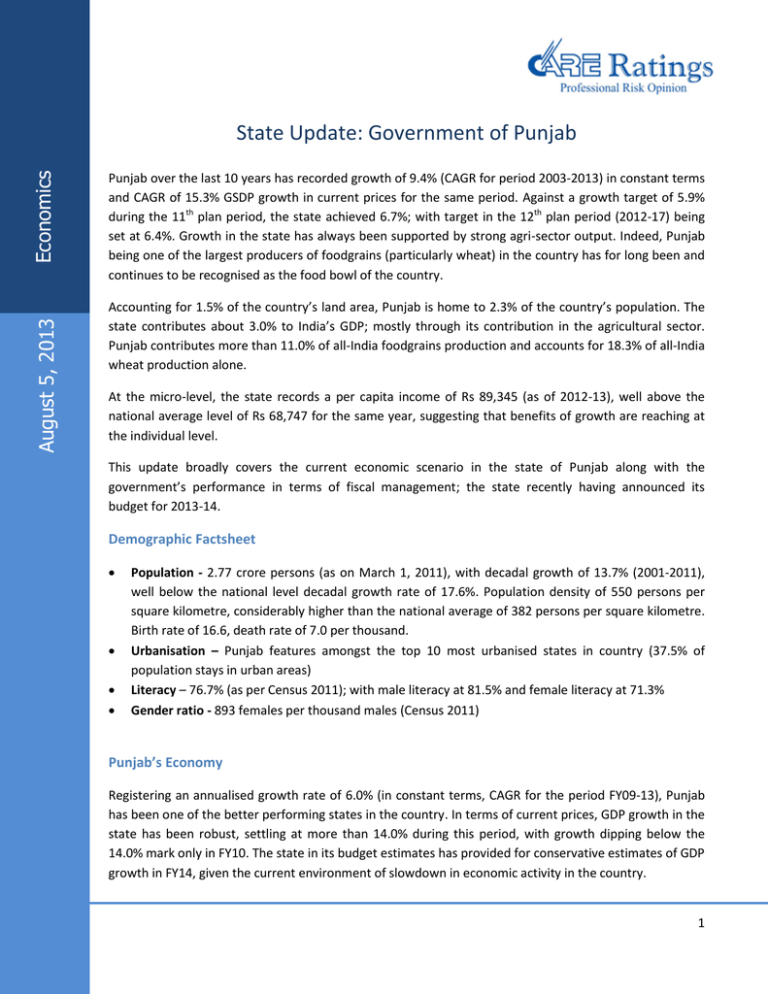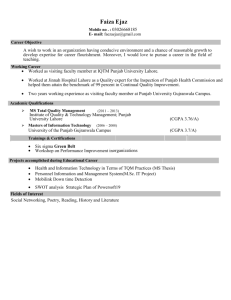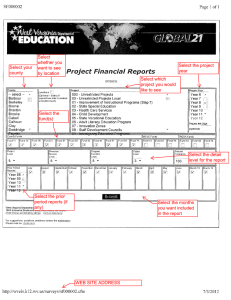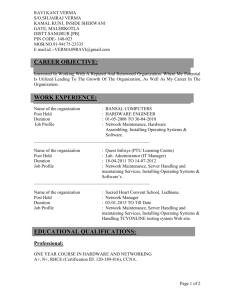State Update: Government of Punjab s
advertisement

August 5, 2013 Economics State Update: Government of Punjab Punjab over the last 10 years has recorded growth of 9.4% (CAGR for period 2003-2013) in constant terms and CAGR of 15.3% GSDP growth in current prices for the same period. Against a growth target of 5.9% during the 11th plan period, the state achieved 6.7%; with target in the 12th plan period (2012-17) being set at 6.4%. Growth in the state has always been supported by strong agri-sector output. Indeed, Punjab being one of the largest producers of foodgrains (particularly wheat) in the country has for long been and continues to be recognised as the food bowl of the country. Accounting for 1.5% of the country’s land area, Punjab is home to 2.3% of the country’s population. The state contributes about 3.0% to India’s GDP; mostly through its contribution in the agricultural sector. Punjab contributes more than 11.0% of all-India foodgrains production and accounts for 18.3% of all-India wheat production alone. At the micro-level, the state records a per capita income of Rs 89,345 (as of 2012-13), well above the national average level of Rs 68,747 for the same year, suggesting that benefits of growth are reaching at the individual level. This update broadly covers the current economic scenario in the state of Punjab along with the government’s performance in terms of fiscal management; the state recently having announced its budget for 2013-14. Demographic Factsheet Population - 2.77 crore persons (as on March 1, 2011), with decadal growth of 13.7% (2001-2011), well below the national level decadal growth rate of 17.6%. Population density of 550 persons per square kilometre, considerably higher than the national average of 382 persons per square kilometre. Birth rate of 16.6, death rate of 7.0 per thousand. Urbanisation – Punjab features amongst the top 10 most urbanised states in country (37.5% of population stays in urban areas) Literacy – 76.7% (as per Census 2011); with male literacy at 81.5% and female literacy at 71.3% Gender ratio - 893 females per thousand males (Census 2011) Punjab’s Economy Registering an annualised growth rate of 6.0% (in constant terms, CAGR for the period FY09-13), Punjab has been one of the better performing states in the country. In terms of current prices, GDP growth in the state has been robust, settling at more than 14.0% during this period, with growth dipping below the 14.0% mark only in FY10. The state in its budget estimates has provided for conservative estimates of GDP growth in FY14, given the current environment of slowdown in economic activity in the country. 1 Economics Sectorally speaking, Punjab’s economy is dominated by the primary and tertiary sectors, which together accounted for 83.5% of the state’s NSDP as of 201112. The agri-sector however, is seen to touch some saturation in case of rice and wheat production in the absence of technological breakthrough. While contribution of industry remains small, it has increased from 13.6% in 2004-05 to 16.5% in 201112. This has been possible with concerted efforts at promotion of public-private partnership mode of operations in the secondary sector coupled with incentives to industry. Exhibit 1: Sectoral Composition of Punjab NSDP 16.5% 51.2% 13.6% 51.8% 2011-12 34.6% 2004-05 32.4% primary secondary tertiary Source: Budget 2013-14, Government of Punjab Budget 2013-14 Budget 2013-14, presents actual accounts (A) for the year 2011-12 and revised estimates (RE) for accounts in 2012-13 along with budgeted estimates (BE) for the year 2013-14. We examine Budget 2013-14 for the state with respect to its revenue and capital accounts and performance thereof Revenue Account Profile Punjab, has been identified, by the Thirteenth Finance Commission, as one of three special states (along with Kerala and West Bengal) to be granted an extended time period of until FY15 to meet fiscal consolidation targets. These states are characterised by high historical debt burden that has negatively impacted their current fiscal position, debt repayment capacity and future potential to raise further debt. Hence, unlike other states, Punjab has a differently defined fiscal consolidation roadmap. In FY12, the state recorded a revenue deficit of Rs 6,811 crore (1.8% of GSDP), which is gradually expected to moderate to Rs 4,759 crore (1.2% of GSDP) in FY13 (RE) and further to Rs 1,746 crore (0.6% of GSDP) in FY14. The state according to recommendations of the Thirteenth Finance Commission (ThFC) is scheduled to eliminate revenue deficit by FY15. Table 1: Revenue Account FY12-FY14 (Rs crore) Revenue A/c Heads FY12 (A) FY13 (RE) Revenue Receipts 26,234 39,269 Tax revenue 22,395 28,352 Non-tax revenue 1,398 4,916 Revenue Expenditure 33,045 44,028 Development expenditure 16,772 22,597 Non-development expenditure 16,788 18,819 Of which, interest expenses 6,280 6,986 Revenue Surplus 6,811 4,759 FY14 (BE) 42,666 33,356 2,736 44,412 22,714 19,121 7,602 1,746 Source: Budget 2013-14, Government of Punjab State Government Update: Punjab 2 Economics On the revenue receipts side, inadequacy of additional resource mobilisation by the state, sluggish tax allocations from the centre and limited scope of increasing the contribution of non-tax revenue receipts in aggregate pool of state revenues has constrained revenue generation and growth. Revenue receipts as a percentage of GSDP stood at 10.1% in FY12; estimated to increase to 13.3% in FY13 and budgeted marginally higher at 13.8% in FY14. Punjab has been awarded a share of 1.39% in shareable taxes (excluding service tax) and 1.4% share of service tax from the centre. The ratio of tax allocations from centre in aggregate revenue receipts of the state stood at 13.6% in FY12. This is budgeted to decline to 11.3% in FY14. The state is seeking to secure a higher share in tax allocations from the centre through the 14th Finance Commission, constituted in January this year. In terms of expenditure, the shares of development expenditure and non-development expenditures are nearly equal. Share of development expenses stood at 50.8% in FY12, budgeted to increase to 51.1% in FY14. Focus areas in developmental spending include infrastructure (power, roads, rural water supply and sanitation), health, education, women empowerment and development of girl child. Non-development expenditure of the state has been dominated by interest expenses, owing to huge debt-size of the state. Interest payment expenses as percentage of revenue expenditure stood at 59.8% in FY12 and is budgeted to rise to 66.0% in FY14 (BE). With continued fiscal assistance to farmers and other poorer sections of society, the state expects revenue outgoes to continue. For instance, the state is committed to providing free power to its 10 lakh farers and up to 200 units of free power to 5 lakh BPL and 18 lakh SC families in the state. The state government compensates the Punjab State Power Corporation Ltd for free power, with the annual liability in FY13 estimated at Rs 5,511 crore and budgeted at Rs 5,785 crore in FY14. Committed expenditure (salaries, wages, pension and interest payments) of the state has been under pressure due to implementation of Sixth Pay Commission recommendations, fresh recruitment in the last 2-3 years and high debt-service obligations. The same as a percentage of revenue receipts stood at 93.0% in FY12. The same is estimated to decline to 71.6% in FY13 and 66.5% in FY14. o The state as per Budget 2013-14 has paid 70.0% of arrears to employees and 67.0% arrears to pensioners. While the last instalment to pensioners was due in FY13, the same has been postponed to FY14 on account of financial constraints. Arrears on salaries/wages are also scheduled to be discharged by FY14. Capital Account Profile The capital account of the state remains in deficit, as shown in table 2 below Table 2: Capital Account FY12-FY14 (Rs crore) Capital A/c Heads FY12 (A) FY13 (RE) Capital Receipts 17,497 24,505 Internal Debt 14,721 21,518 Loans from GoI 150 348 Capital Expenditure 10,722 19,437 Capital Outlay 1,598 4,528 Repayment of Public Debt 8,947 14,662 Capital A/c deficit -6,775 -5,068 FY14 (BE) 26,346 23,412 542 24,639 7,283 16,988 -1,707 Source: Budget 2013-14, Government of Punjab State Government Update: Punjab 3 Economics Internal debt of the state accounts for major share of capital receipts, 84.1% in FY12. This is budgeted to increase to 88.9% in FY14. Accordingly, the share of loans from the centre form a miniscule portion of total capital receipts of the state (0.9% in FY12 and 2.1% in FY14 (BE)). Given the fiscal profile of the state of Punjab, that has historically been weighed by debt and debt-service concerns, developmental capital expenditure forms a smaller share in total capex when compared with debt repayments. o Developmental expenditure stood at 21.0% of total capex in FY13, budgeted to increase marginally to 24.3% in FY14. o Repayment of public debt as a percentage of total capex stood at 75.4% in FY13, which is budgeted to moderate to 69.0% in FY14. Budget Management & Fiscal Prudence As mentioned earlier, fiscal sustainability of Punjab has historically been adversely impacted by high debt levels and debt service burden. RD/GSDP FD/GSDP Debt/GSDP Table 3: Key fiscal and debt norms ThFC Target ThFC Target ThFC Target 2011-12 2012-13 2014-15 1.8% 1.2% 0.0% 3.5% 3.5% 3.0% 41.8% 41.0% 38.7% Achievement 2012-13 1.6% 3.2% 33.3% Source: Budget 2013-14, Government of Punjab When comparing, the fiscal roadmap for Punjab, as set out by the ThFC, with achievement in FY13, a slippage is noticed in the RD target. RD/GSDP ratio stood at 1.6% in FY13 (RE) as against a target of 1.2%, because revenue receipts have not been forthcoming. On the other hand, fiscal deficit and debt ratios have been within prescribed targets. While the state has imposed prudential ceilings on guarantees, it has neither created a consolidated sinking fund (CSF) nor guarantee redemption fund (GRF) as a fund base, essential to back its debt portfolio in case of contingencies. Punjab availed of 177 days of ways and means advances (WMA) in FY12 and 163 days in FY13 (up to January 1, 2013) from RBI. It has also availed of 26 days of overdraft (OD) in FY12 and 107 days in FY13 (up to January 1, 2013). In general, OD facility is accessed in order to tide over temporary liquidity mismatches. Contact: Madan Sabnavis Chief Economist Madan.sabnavis@careratings.com 91-022-67543489 Krithika Subramanian Associate Economist krithika.subramanian@careratings.com 91-022-67543521 Disclaimer This report is prepared by the Economics Division of Credit Analysis & Research Limited [CARE]. CARE has taken utmost care to ensure accuracy and objectivity while developing this report based on information available in public domain. However, neither the accuracy nor completeness of information contained in this report is guaranteed. CARE is not responsible for any errors or omissions in analysis/inferences/views or for results obtained from the use of information contained in this report and especially states that CARE (including all divisions) has no financial liability whatsoever to the user of this report. State Government Update: Punjab 4



